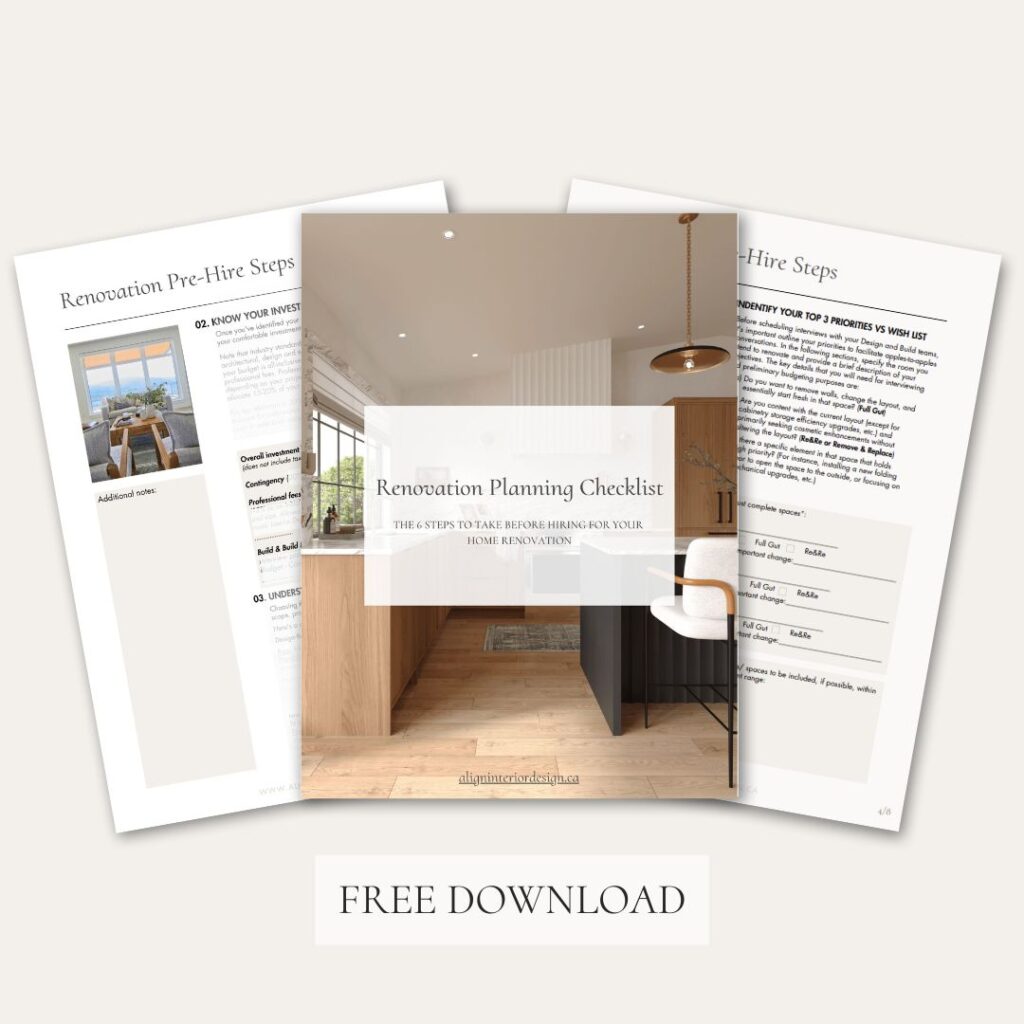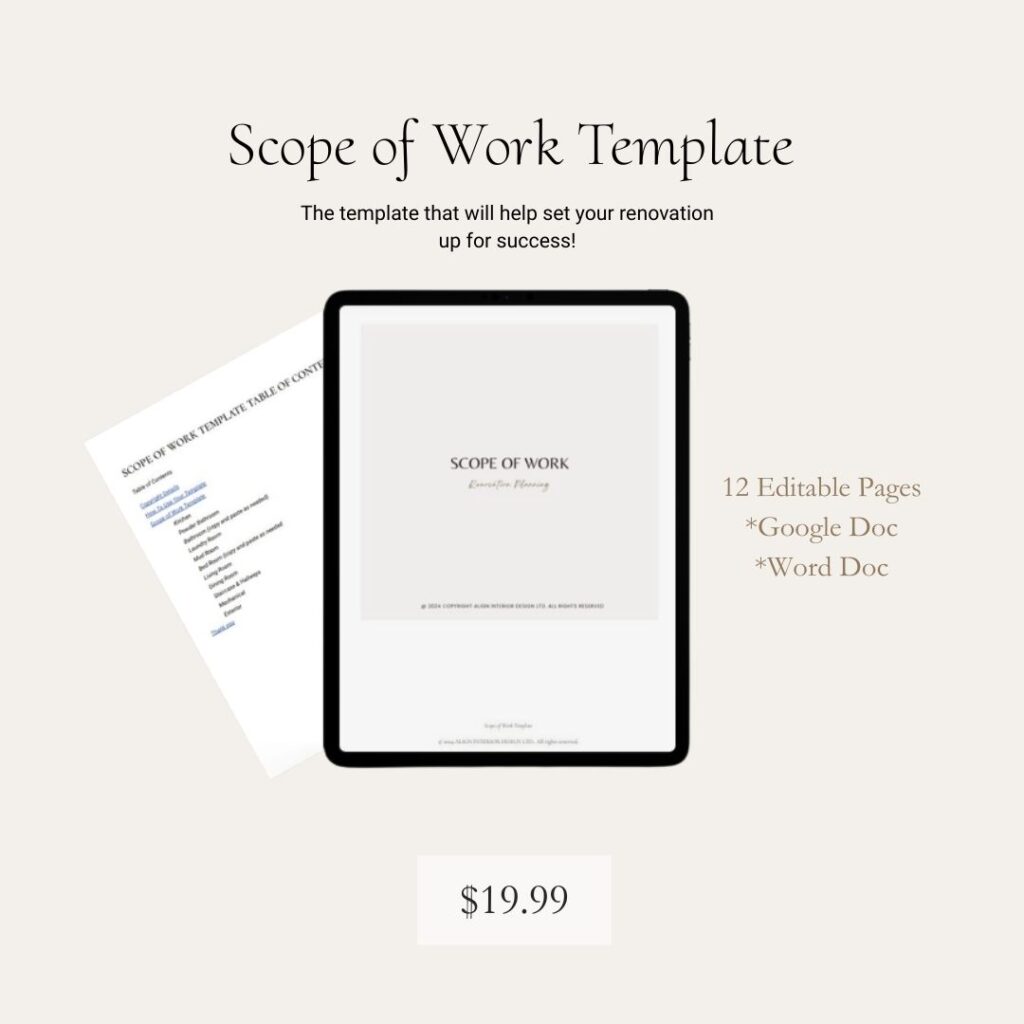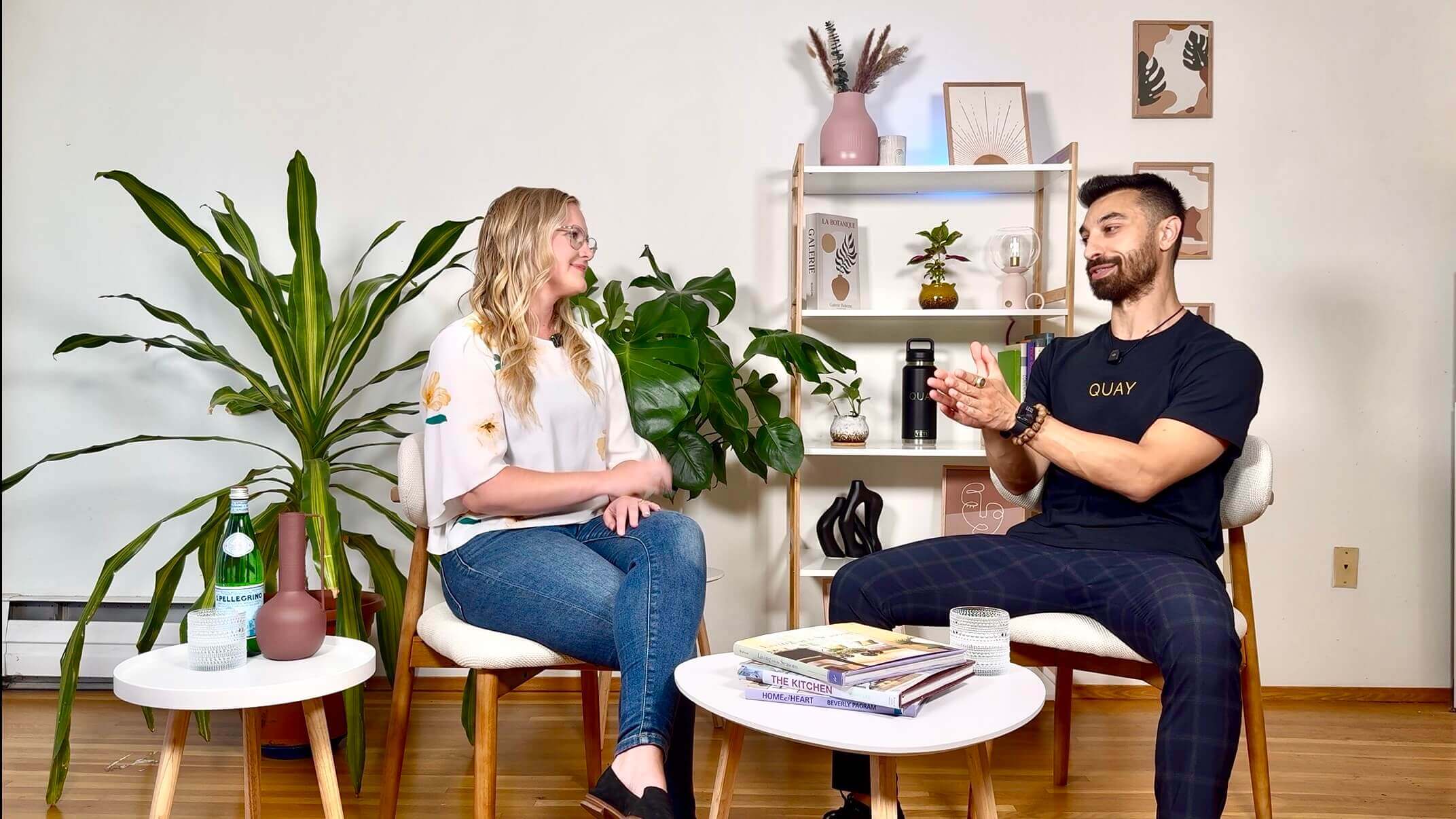Renovating your home should feel exciting—not overwhelming. With the right plan and the right team, it truly can be. When you have clear steps mapped out, you’re able to keep your budget in check, avoid unnecessary stress, and actually enjoy the process.
Recently, I joined Matin on the Quay Insights Podcast to chat about exactly how to make that happen. We dove into how homeowners can prepare for a renovation, what to ask your designer, and the simple systems that prevent decision fatigue. You’ll also hear some practical tips (and a few stories!) about making smart design choices that deliver big impact without blowing the budget.
Review the Transcript
Matin, Quay Construction: Rebecca from Align Interior Design. Rebecca, I’m really excited to have you here. Tell us a little bit about yourself and Align Interior Design.
Rebecca Foster, Align Interior Design: Well, thank you so much for having me. I’m honored to be here. I’m Rebecca Foster, the owner of Align Interior Design. We’re a Pitt Meadows–based interior design firm focusing mainly on residential projects. We essentially help homeowners reduce decision fatigue, avoid costly mistakes, and love the home that they’re in.
Matin, Quay Construction: How did you get into interior design?
Rebecca Foster, Align Interior Design: Well, outside of every single interior designer rearranging their bedroom and that kind of thing, there was really one pivotal moment. To be perfectly honest, my parents actually— I don’t think I’ve ever told you this— did a renovation when we were younger, but it wasn’t planned.
In our basement, the drywall was bowing because the studs were bowing behind it. Eventually, we woke up in the middle of the night and it sounded like a gunshot—one of those studs snapped. Essentially, a part of our foundation was sinking, so we had to support it.
The reason I think I fell in love with interior design is because we are a very DIY family and were very involved in the process. Small town, kind of like our neighbors and everybody helped out. We have pictures of us putting up walls, bashing through walls, as kids.
Then I saw how my family went from literally never inviting anybody over to our house, to speaking about their home with pride. We wanted to invite our friends over, and I really saw how the space you live in can shape how you act, how you feel, and your confidence. That sense of pride is really what I want to give my clients. It changed who I am and really shaped me—just by a simple renovation. It might sound cheesy, but it was a pivotal moment, and that’s why I love design.
Matin, Quay Construction: I know you take an “educate first, create next” approach, which is what we do at Quay as well. Tell us a little bit about how that impacts your clients.
Rebecca Foster, Align Interior Design: Absolutely. We focus on how the layout functions and on educating clients through the pros and cons of every material, and how that affects budget and lifestyle.
Most of my clients are in one of two categories: either busy professionals with young families, or those thinking about retirement (sometimes even with parents aging in place). We want to strategically ask the right questions so I can guide clients through what I recommend.
Things as simple as a countertop—do you want maintenance? Do you have young kids? Do you have friends who spill wine? Do you love marble but know you won’t maintain it? Those conversations matter.
We focus heavily on education, then layer in the visuals—like 3D renderings—at the end. The reason I created this approach is because early in my career, I asked a senior designer about her process. I wanted to mimic her method so clients got a consistent experience, but she told me she did it differently every time.
That baffled me. I wanted a consistent experience for every client, no matter the designer. Over the years, I created this “educate first, create second” approach to ensure that.
Matin, Quay Construction: Yeah, I think that’s one of the reasons why I really like your work. We have a set process at Quay as well, and that level of organization makes it easier for clients and for the team.
Rebecca Foster, Align Interior Design: Exactly. An organized design and construction team makes it so much easier on clients, and easier on the trades too—because everyone knows what to expect at each level.
Matin, Quay Construction: One of the things I’ve been talking about recently is how clients pick contractors. I want to shift that to how clients pick designers. Are there questions clients should be asking that they often don’t?
Rebecca Foster, Align Interior Design: Yes—“What do you need from me, and when do you need it?” That’s so important. Some designers will hold your hand through every single detail, and some won’t. Depending on your personality, you might be better suited to one or the other.
Matin, Quay Construction: Where do you land on that?
Rebecca Foster, Align Interior Design: I’m very collaborative. I want to design with you, but I’m not your shopping bestie. I’ll guide you, pick everything, and organize it—but typically I’ll connect you with my trusted showroom reps. Clients usually prefer visiting once, narrowing options, then sending them back to me to finalize. That process works really well.
Matin, Quay Construction: How do you help clients avoid decision fatigue?
Rebecca Foster, Align Interior Design: The first thing we do is pre-book every single meeting—usually once every two weeks for about 90 minutes. Each meeting has a clear topic. Afterward, I send a recap email outlining what we discussed, plus any homework and deadlines.
This keeps us on track with fixed fees and timelines, and prevents overwhelm. Clients aren’t juggling every decision at once—we break it down step by step.
Matin, Quay Construction: What’s a big mistake homeowners make when prepping for a renovation?
Rebecca Foster, Align Interior Design: Starting demolition before they have a full construction budget or a complete design. Sometimes I get calls when framing has already started, and that’s tough. Without a plan, you miss the chance to value-engineer or adjust scope over a cup of coffee—before money is spent and stress kicks in.
Matin, Quay Construction: What’s one spec that surprises homeowners with its cost?
Rebecca Foster, Align Interior Design: Window coverings. They’re often forgotten in the budget and can be a shock. Plumbing can vary widely, but window coverings consistently surprise people.
Matin, Quay Construction: What’s one project where a design decision went wrong?
Rebecca Foster, Align Interior Design: It usually happens when changes are made mid-construction without consulting the designer. Swapping out finishes can create a piecemealed look at the end. That’s why collaboration between design and construction teams is critical. Without it, clients end up stressed and compromising too much.
Matin, Quay Construction: What’s one trend from Pinterest that doesn’t work in real life?
Rebecca Foster, Align Interior Design: Staircases. Many inspiration photos show horizontal cabling or ornate designs that don’t meet Vancouver code. They might look great online, but they’re not always buildable.
Matin, Quay Construction: What’s your best advice for clients just starting to plan a renovation?
Rebecca Foster, Align Interior Design: Start early. Have a clear scope of work, realistic budget expectations, and reach out to both designers and contractors sooner than you think. Pre-planning is everything.
Matin, Quay Construction: For budgeting, do you work through that with clients or rely on the contractor?
Rebecca Foster, Align Interior Design: Both. I can give educated ballparks based on experience, but once we have a floor plan, I prefer collaborating with the contractor for a conceptual budget. That ensures nothing is missed and gives clients a full picture early on.
Matin, Quay Construction: What’s one cost-effective change that makes a big impact?
Rebecca Foster, Align Interior Design: Color drenching. Paint the walls, ceilings, and trim the same color—it instantly creates a moody, elevated look, especially in bedrooms or dens.
Matin, Quay Construction: What’s one trend you wouldn’t mind seeing go away?
Rebecca Foster, Align Interior Design: Gray flooring. It’s very trendy and already starting to feel dated. I prefer designing with longevity in mind.
Matin, Quay Construction: For clients who want to connect with you, what’s the best way?
Rebecca Foster, Align Interior Design: Visit aligninteriordesign.ca. You can also download my free How to Prepare for Your Renovation Guide at aligninteriordesign.ca/reno. Or connect with me on Instagram.
Matin, Quay Construction: Awesome. Thank you for joining us today.
Rebecca Foster, Align Interior Design: Thank you—so fun!
Why This Conversation Matters / What You’ll Learn in This Episode
I know firsthand how overwhelming it can feel to choose the right designer or contractor. That’s why I created my Educate First, Create Second approach. When the process is structured and collaborative, your renovation shifts from stressful to genuinely enjoyable experience.
In my conversation with Quay Construction, we cover the essentials every homeowner should know before starting a project, including:
✓ How to confidently choose the right interior designer for your style, budget, and goals
✓ The #1 mistake homeowners make when preparing for a renovation and how to avoid it
✓ How to prevent decision fatigue when there are 200+ renovation choices to make
✓ Why collaboration between your designer and contractor is non-negotiable
✓ Small but cost-effective upgrades (from smart cabinet inserts to colour-drenched walls) that deliver big transformations
This episode is designed to give you the clarity and practical tools you need to move forward with your refresh or renovation the right way.
My Story (and Why I Care So Much About This Work)
My passion for design started at 12, when my family’s farmhouse foundation began collapsing. Overnight, walls cracked, studs snapped, and we were thrown into a renovation we weren’t prepared for.
What could have been just a stressful and expensive repair ended up showing me how deeply our homes affect our confidence and joy. After the transformation, my parents felt proud to invite friends over. Our confidence grew. That renovation changed how we felt about ourselves and I carry that experience with me into every project I take on today.
My goal is simple. I want you to love where you live, with zero renovation regrets. That’s why at Align Interior Design, we follow our signature process: educate first, create second.
Our “Educate First, Create Second” Approach
Too often, design is treated like a hand-off. You get a mood board, maybe a drawing, and then you’re left on your own once construction starts. I call that “design and dash,” and I’m not a fan.
Instead, I guide clients through:
✓ Evaluating functionality and layout before even talking about finishes
✓ Weighing the pros and cons of materials (because a marble countertop sounds dreamy until you realize how high-maintenance it is)
✓ Understanding how every design choice affects both lifestyle and budget
Once that foundation is clear, we layer in visuals like 3D renderings so you can see your space come to life. This structured process keeps my clients confident and not overwhelmed by all the hundred decisions every renovation requires.
Questions Every Homeowner Should Ask Before Hiring a Designer
- What’s your process, and how long does it take?
This reveals how organized they are. If they can’t outline a clear, step-by-step process and timeline, that’s a red flag.
- What do you need from me, and when do you need it?
Some designers hold your hand; others expect more independence. Some are “shopping besties” who go to every showroom with you. Others (like me) give curated recommendations and structured guidance so you can shop efficiently without wasting time. Knowing this upfront avoids surprises.
- How do you help prevent decision fatigue?
Renovations come with hundreds of decisions: paint colours, plumbing fixtures, cabinet inserts, tile layouts, lighting. Ask how they break down decisions and keep you on track.
Here’s how I keep my clients sane:
✓ Pre-book all meetings so we know exactly what decisions we’ll tackle and when
✓ Focus on specific topics each time (e.g., one meeting just for plumbing, one for flooring) so we’re never spinning wheels on everything at once
✓ Send recap emails after every meeting (with homework clearly outlined) so clients know exactly what to prioritize
For a full list of questions you should be asking your Interior Designer, check out this blog post: [ Questions to Ask Your Interior Designer Before Hiring ]
The Biggest Mistake Homeowners Make When Renovating Their Home
If I could give one piece of advice, it’s this: don’t start demolition without a plan.
When you tear down walls before finalizing your design and budget, you’re setting yourself up for stressful compromises. It’s far easier and less expensive to refine your scope and budget over coffee before the demo, instead of scrambling mid-construction.
Helpful resources:

6 Steps To Take Before Hiring For Your Renovation

Home Renovation Scope of Work Template
Cost-Effective Upgrades That Make a Big Impact
Renovations don’t always have to mean gut jobs and six-figure budgets. Sometimes, small choices make a huge difference:
✓ Cabinet inserts and drawer organizers: Boost kitchen function without touching the layout.
✓ Colour drenching: Instead of just painting a feature wall, try painting everything (walls, trim, ceiling, doors) the same hue. It’s moody, dramatic, and costs little more than a few extra gallons of paint.
![[Check out our West Coast Drift Project where we colour-drenched this bedroom. The walls, trims & ceiling were all the same colour.]](https://aligninteriordesign.ca/wp-content/uploads/sites/39961/2025/09/AlignInteriorDesign-WestCoastDrift-Bedroom8-1024x683.jpg)
[Check out our West Coast Drift Project where we colour-drenched this bedroom. The walls, trims & ceiling were all the same colour.]
✓ Thoughtful window coverings: Often overlooked, but one of the most impactful elements of comfort and design.
Curious about other affordable design tricks? Watch the full episode to learn how to prioritize where to spend and where to save.
Why Collaboration Matters
Design and construction should never feel like separate teams. When contractors and designers don’t communicate, projects often feel piecemealed with last-minute compromises that affect the final result.
The best outcomes happen when your designer and contractor work together from day one—problem-solving behind the scenes so you don’t feel like you’re constantly compromising.
While asking the right questions is crucial, selecting the right contractor is equally important. Here’s an in depth guide on how to choose the best renovation contractor which offers practical tips to ensure your project runs smoothly and turns out exactly as you envision.
A big thank-you to Matin and the Quay Insights Podcast team for having me on to share my perspective. If you’d like to listen to the full conversation, you can catch the replay above.
Your Next Step
Planning a reno soon? Don’t start without my free step-by-step prep guide: How to Prepare for Your Renovation. This resource will help you clarify your scope of work, budget with confidence, and avoid the common mistakes we covered in this post.
P.S. Did you know I host a 9-episode podcast series called No Regrets Renovation? On the podcast, I walk you through our design service options, share what it’s really like to work with an interior designer, and even talk openly about what it costs. You can [check out our podcast page] to explore each episode and decide which one you’d like to dive into next.
